2016 NISSAN ROGUE fuel
[x] Cancel search: fuelPage 447 of 478
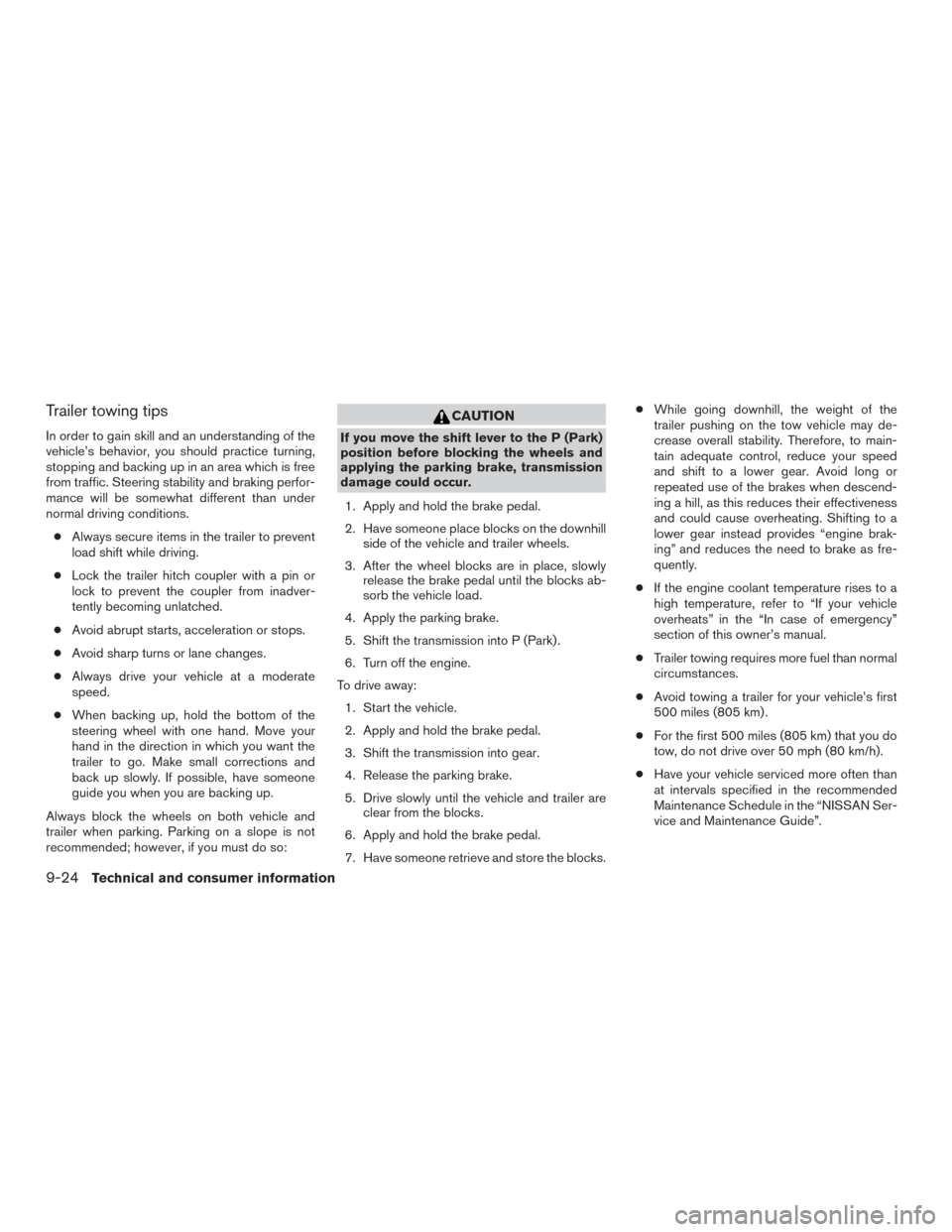
Trailer towing tips
In order to gain skill and an understanding of the
vehicle’s behavior, you should practice turning,
stopping and backing up in an area which is free
from traffic. Steering stability and braking perfor-
mance will be somewhat different than under
normal driving conditions.● Always secure items in the trailer to prevent
load shift while driving.
● Lock the trailer hitch coupler with a pin or
lock to prevent the coupler from inadver-
tently becoming unlatched.
● Avoid abrupt starts, acceleration or stops.
● Avoid sharp turns or lane changes.
● Always drive your vehicle at a moderate
speed.
● When backing up, hold the bottom of the
steering wheel with one hand. Move your
hand in the direction in which you want the
trailer to go. Make small corrections and
back up slowly. If possible, have someone
guide you when you are backing up.
Always block the wheels on both vehicle and
trailer when parking. Parking on a slope is not
recommended; however, if you must do so:
CAUTION
If you move the shift lever to the P (Park)
position before blocking the wheels and
applying the parking brake, transmission
damage could occur.
1. Apply and hold the brake pedal.
2. Have someone place blocks on the downhill side of the vehicle and trailer wheels.
3. After the wheel blocks are in place, slowly release the brake pedal until the blocks ab-
sorb the vehicle load.
4. Apply the parking brake.
5. Shift the transmission into P (Park) .
6. Turn off the engine.
To drive away: 1. Start the vehicle.
2. Apply and hold the brake pedal.
3. Shift the transmission into gear.
4. Release the parking brake.
5. Drive slowly until the vehicle and trailer are clear from the blocks.
6. Apply and hold the brake pedal.
7. Have someone retrieve and store the blocks. ●
While going downhill, the weight of the
trailer pushing on the tow vehicle may de-
crease overall stability. Therefore, to main-
tain adequate control, reduce your speed
and shift to a lower gear. Avoid long or
repeated use of the brakes when descend-
ing a hill, as this reduces their effectiveness
and could cause overheating. Shifting to a
lower gear instead provides “engine brak-
ing” and reduces the need to brake as fre-
quently.
● If the engine coolant temperature rises to a
high temperature, refer to “If your vehicle
overheats” in the “In case of emergency”
section of this owner’s manual.
● Trailer towing requires more fuel than normal
circumstances.
● Avoid towing a trailer for your vehicle’s first
500 miles (805 km) .
● For the first 500 miles (805 km) that you do
tow, do not drive over 50 mph (80 km/h).
● Have your vehicle serviced more often than
at intervals specified in the recommended
Maintenance Schedule in the “NISSAN Ser-
vice and Maintenance Guide”.
9-24Technical and consumer information
Page 455 of 478
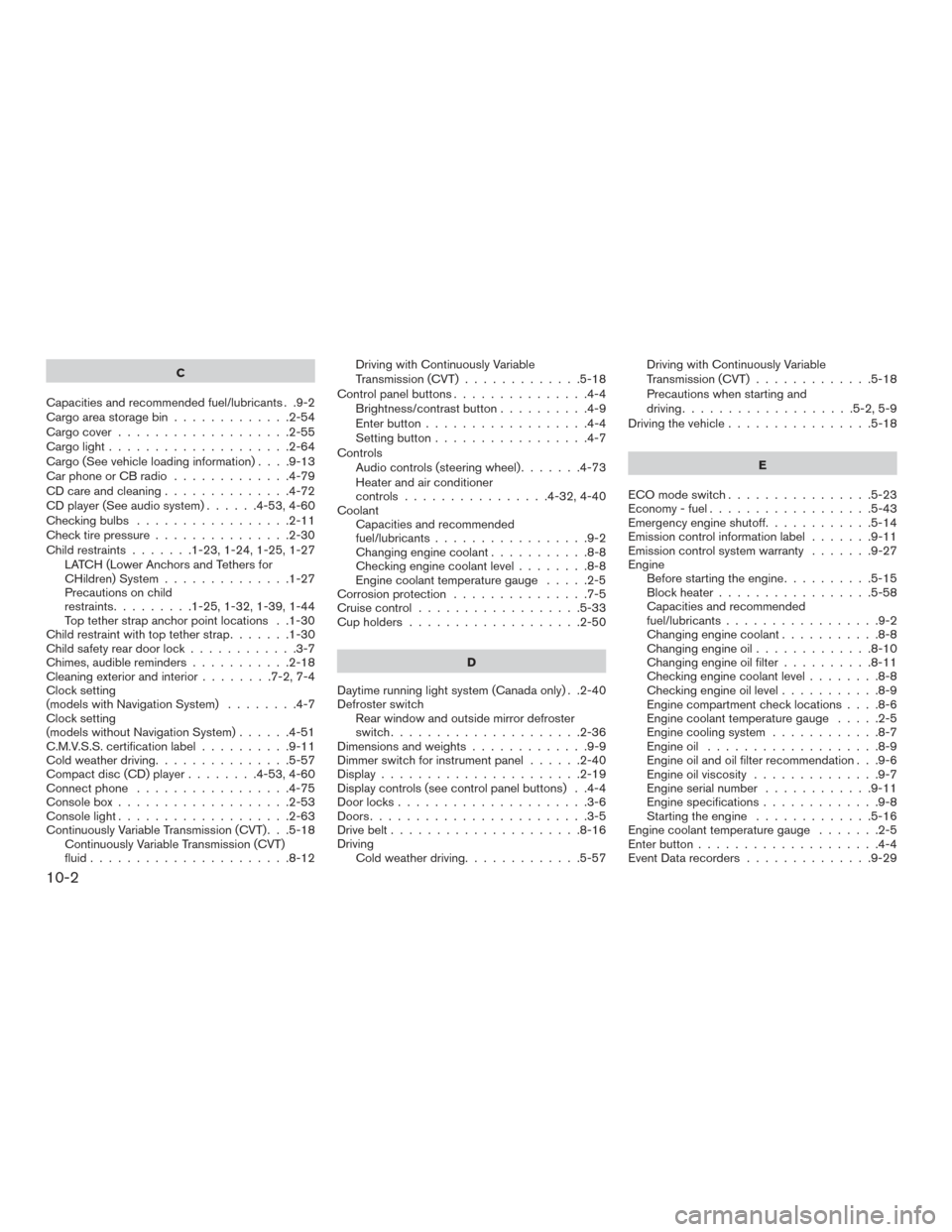
C
Capacities and recommended fuel/lubricants . .9-2
Cargoareastoragebin.............2-54
Cargocover...................2-55
Cargolight....................2-64
Cargo(Seevehicleloadinginformation)....9-13
Car phone or CB radio .............4-79
CD care and cleaning ..............4-72
CD player (See audio system) ......4-53,4-60
Checkingbulbs .................2-11
Check tire pressure ...............2-30
Child restraints .......1-23,1-24,1-25,1-27
LATCH (Lower Anchors and Tethers for
CHildren) System ..............1-27
Precautions on child
restraints.........1-25,1-32,1-39,1-44
Top tether strap anchor point locations . .1-30
Child restraint with top tether strap .......1-30
Child safety rear door lock ............3-7
Chimes, audible reminders ...........2-18
Cleaningexteriorandinterior........7-2,7-4
Clock setting
(models with Navigation System) ........4-7
Clock setting
(models without Navigation System) ......4-51
C.M.V.S.S. certification label ..........9-11
Cold weather driving ...............5-57
Compact disc (CD) player ........4-53,4-60
Connect phone .................4-75
Consolebox...................2-53
Consolelight...................2-63
Continuously Variable Transmission (CVT) . . .5-18 Continuously Variable Transmission (CVT)
fluid ......................8-12 Driving with Continuously Variable
Transmission (CVT)
.............5-18
Control panel buttons ...............4-4
Brightness/contrast button ..........4-9
Enterbutton..................4-4
Setting button .................4-7
Controls Audio controls (steering wheel) .......4-73
Heater and air conditioner
controls................4-32,4-40
Coolant Capacities and recommended
fuel/lubricants .................9-2
Changingenginecoolant...........8-8
Checking engine coolant level ........8-8
Engine coolant temperature gauge .....2-5
Corrosion protection ...............7-5
Cruisecontrol..................5-33
Cupholders...................2-50
D
Daytime running light system (Canada only) . .2-40
Defroster switch Rear window and outside mirror defroster
switch.....................2-36
Dimensionsandweights.............9-9
Dimmer switch for instrument panel ......2-40
Display......................2-19
Display controls (see control panel buttons) . .4-4
Door locks .....................3-6
Doors ........................3-5
Drive belt .....................8-16
Driving Cold weather driving .............5-57 Driving with Continuously Variable
Transmission (CVT)
.............5-18
Precautions when starting and
driving ...................5-2,5-9
Driving the vehicle ................5-18
E
ECO mode switch ................5-23
Economy-fuel..................5-43
Emergency engine shutoff ............5-14
Emission control information label .......9-11
Emission control system warranty .......9-27
Engine Before starting the engine ..........5-15
Blockheater.................5-58
Capacities and recommended
fuel/lubricants.................9-2
Changing engine coolant ...........8-8
Changingengineoil.............8-10
Changing engine oil filter ..........8-11
Checking engine coolant level ........8-8
Checking
engine oil level ...........8-9
Engine compartment check locations ....8-6
Engine coolant temperature gauge .....2-5
Engine cooling system ............8-7
Engineoil ...................8-9
Engine oil and oil filter recommendation . . .9-6
Engine oil viscosity ..............9-7
Engine serial number ............9-11
Engine specifications .............9-8
Starting the engine .............5-16
Engine coolant temperature gauge .......2-5
Enter button ....................4-4
Event Data recorders ..............9-29
10-2
Page 456 of 478
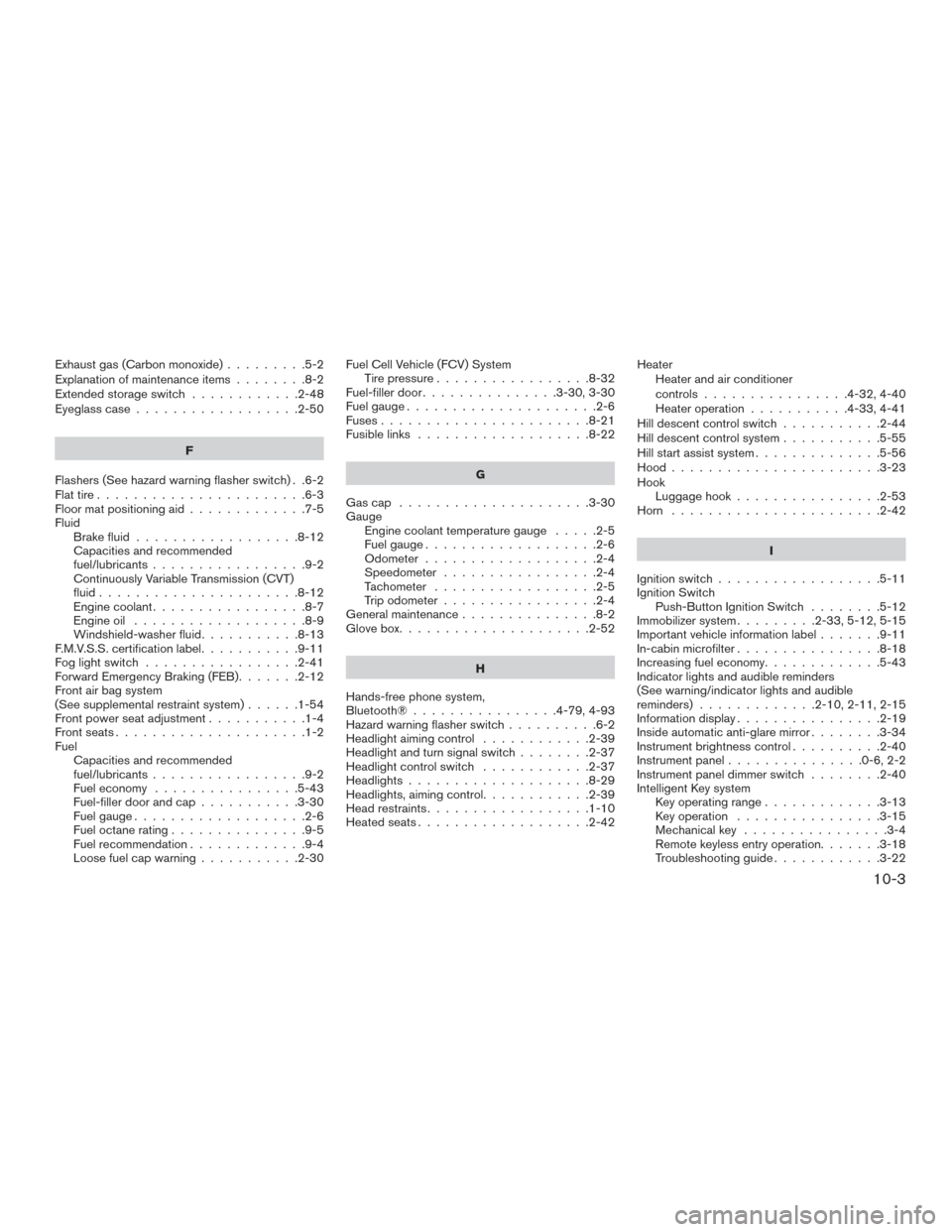
Exhaust gas (Carbon monoxide).........5-2
Explanation of maintenance items ........8-2
Extendedstorageswitch ............2-48
Eyeglass case ..................2-50
F
Flashers (See hazard warning flasher switch) . .6-2
Flat tire .......................6-3
Floor mat positioning aid .............7-5
Fluid Brake fluid ..................8-12
Capacities and recommended
fuel/lubricants .................9-2
Continuously Variable Transmission (CVT)
fluid......................8-12
Engine coolant .................8-7
Engine oil ...................8-9
Windshield-washerfluid...........8-13
F.M.V.S.S. certification label ...........9-11
Foglightswitch .................2-41
Forward Emergency Braking (FEB) .......2-12
Front air bag system
(See supplemental restraint system) ......1-54
Front power seat adjustment ...........1-4
Frontseats.....................1-2
Fuel Capacities and recommended
fuel/lubricants .................9-2
Fuel economy ................5-43
Fuel-filler door and cap ...........3-30
Fuel gauge ...................2-6
Fuel octane rating ...............9-5
Fuel recommendation .............9-4
Loose fuel cap warning ...........2-30 Fuel Cell Vehicle (FCV) System
Tirepressure.................8-32
Fuel-filler door ...............3-30,3-30
Fuelgauge.....................2-6
Fuses.......................8-21
Fusiblelinks ...................8-22
G
Gascap .....................3-30
Gauge Engine coolant temperature gauge .....2-5
Fuel gauge ...................2-6
Odometer ...................2-4
Speedometer .................2-4
Tachometer ..................2-5
Trip odometer .................2-4
General maintenance ...............8-2
Glovebox.....................2-52
H
Hands-free phone system,
Bluetooth®................4-79,4-93
Hazard warning flasher switch ..........6-2
Headlight aiming control ............2-39
Headlight and turn signal switch ........2-37
Headlight control switch ............2-37
Headlights ....................8-29
Headlights, aiming control ............2-39
Head restraints ..................1-10
Heated seats ...................2-42 Heater
Heater and air conditioner
controls ................4-32,4-40
Heater operation ...........4-33,4-41
Hill descent control switch ...........2-44
Hill descent control system ...........5-55
Hill start assist system ..............5-56
Hood.......................3-23
Hook Luggage hook ................2-53
Horn .......................2-42
I
Ignition
switch ..................5-11
Ignition Switch Push-Button Ignition Switch ........5-12
Immobilizer system .........2-33,5-12,5-15
Important vehicle information label .......9-11
In-cabin microfilter ................8-18
Increasing fuel economy .............5-43
Indicator lights and audible reminders
(See warning/indicator lights and audible
reminders).............2-10,2-11,2-15
Information display ................2-19
Inside automatic anti-glare mirror ........3-34
Instrument brightness control ..........2-40
Instrumentpanel...............0-6,2-2
Instrument panel dimmer switch ........2-40
Intelligent Key system Key operating range .............3-13
Key operation ................3-15
Mechanical key ................3-4
Remote keyless entry operation.......3-18
Troubleshooting guide ............3-22
10-3
Page 457 of 478
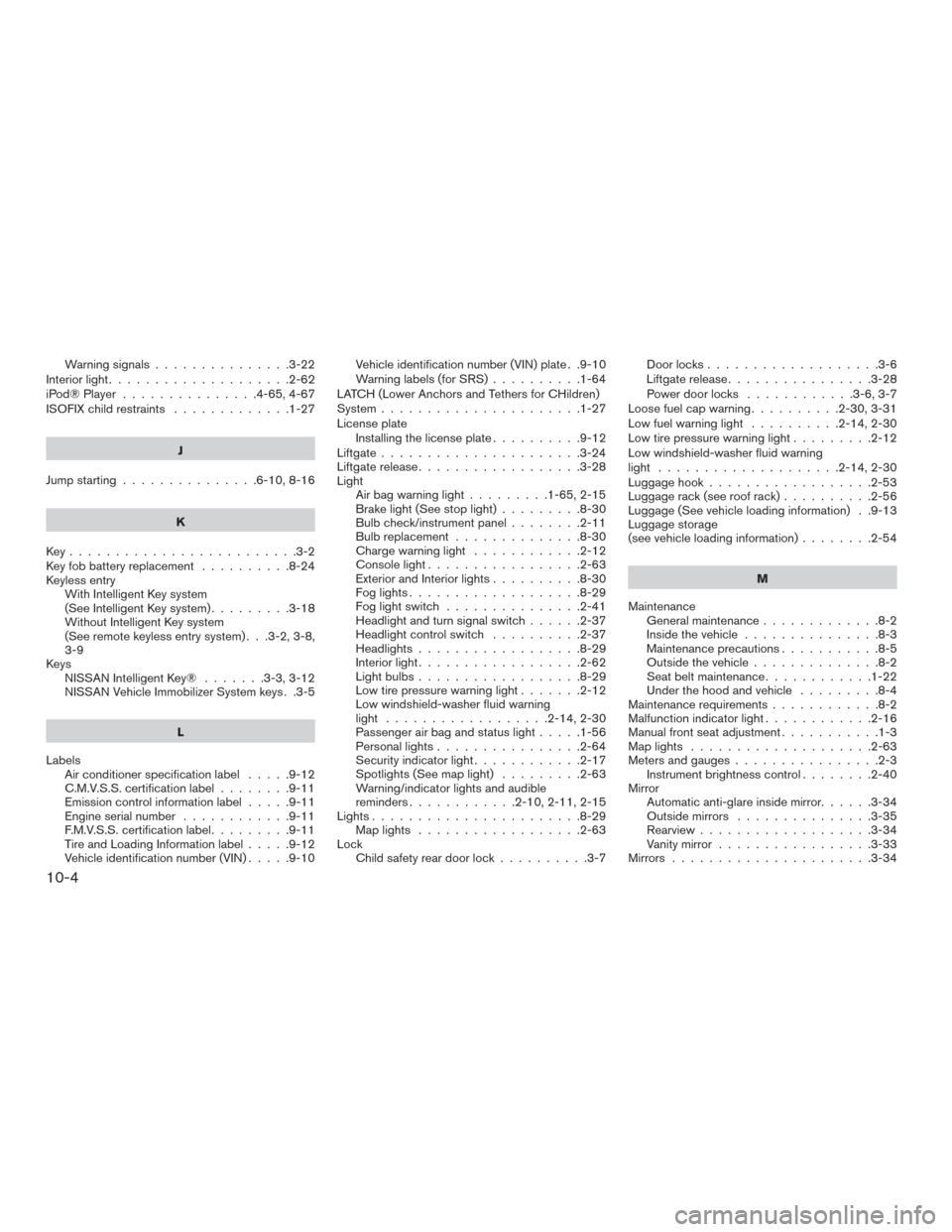
Warning signals...............3-22
Interiorlight....................2-62
iPod®Player ...............4-65,4-67
ISOFIX child restraints .............1-27
J
Jump starting ...............6-10,8-16
K
Key.........................3-2
Key fob battery replacement ..........8-24
Keyless entry With Intelligent Key system
(See Intelligent Key system) .........3-18
Without Intelligent Key system
(See remote keyless entry system) . . .3-2, 3-8,
3-9
Keys NISSAN Intelligent Key® .......3-3,3-12
NISSAN Vehicle Immobilizer System keys . .3-5
L
Labels Air conditioner specification label .....9-12
C.M.V.S.S. certification label ........9-11
Emissioncontrolinformationlabel.....9-11
Engine serial number ............9-11
F.M.V.S.S. certification label .........9-11
Tire and Loading Information label .....9-12
Vehicle identification number (VIN) .....9-10Vehicle identification number (VIN) plate . .9-10
Warning labels (for SRS)
..........1-64
LATCH (Lower Anchors and Tethers for CHildren)
System ......................1-27
License plate Installing the license plate ..........9-12
Liftgate ......................3-24
Liftgate release ..................3-28
Light Air bag warning light .........1-65,2-15
Brake light (See stop light) .........8-30
Bulb check/instrument panel ........2-11
Bulbreplacement..............8-30
Charge warning light ............2-12
Consolelight.................2-63
Exterior and Interior lights ..........8-30
Foglights...................8-29
Foglightswitch ...............2-41
Headlight and turn signal switch ......2-37
Headlight control switch ..........2-37
Headlights..................8-29
Interiorlight..................2-62
Lightbulbs..................8-29
Low tire pressure warning light .......2-12
Low windshield-washer fluid warning
light ..................2-14,2-30
Passenger air bag and status light .....1-56
Personal lights ................2-64
Security indicator light ............2-17
Spotlights(Seemaplight) .........2-63
Warning/indicator lights and audible
reminders ............2-10,2-11,2-15
Lights.......................8-29 Maplights ..................2-63
Lock Child safety rear door lock ..........3-7 Door locks
...................3-6
Liftgate release ................3-28
Power door locks ............3-6,3-7
Loose fuel cap warning ..........2-30,3-31
Low fuel warning light ..........2-14,2-30
Low tire pressure warning light .........2-12
Low windshield-washer fluid warning
light ....................2-14,2-30
Luggage hook ..................2-53
Luggage rack (see roof rack) ..........2-56
Luggage (See vehicle loading information) . .9-13
Luggage storage
(see vehicle loading information) ........2-54
M
Maintenance General maintenance .............8-2
Insidethevehicle...............8-3
Maintenance precautions ...........8-5
Outside the vehicle ..............
8-2
Seat belt maintenance ............1-22
Under the hood and vehicle .........8-4
Maintenance requirements ............8-2
Malfunction indicator light ............2-16
Manual front seat adjustment ...........1-3
Maplights ....................2-63
Meters and gauges ................2-3
Instrument brightness control ........2-40
Mirror Automatic anti-glare inside mirror ......3-34
Outside mirrors ...............3-35
Rearview ...................3-34
Vanity mirror .................3-33
Mirrors ......................3-34
10-4
Page 458 of 478
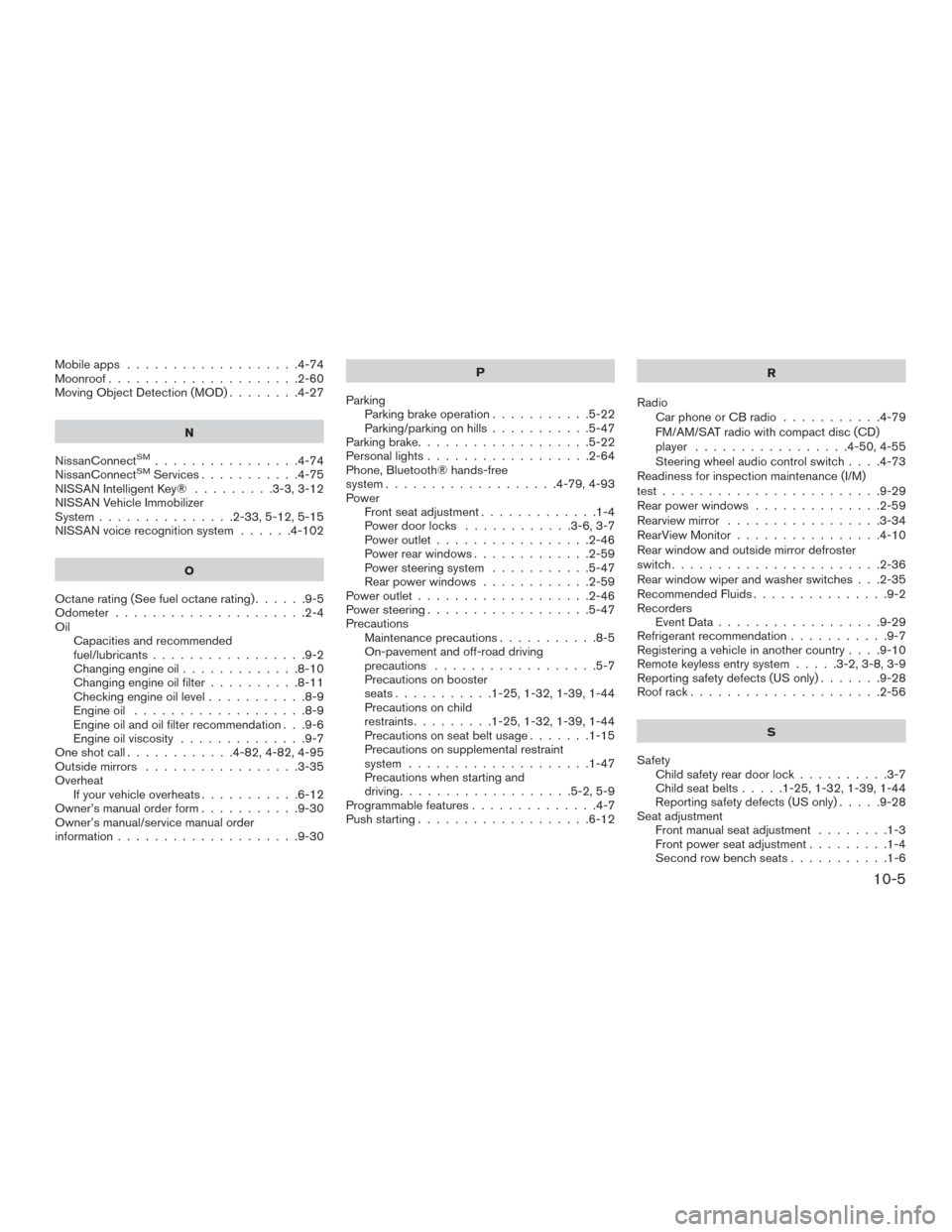
Mobileapps ...................4-74
Moonroof.....................2-60
Moving Object Detection (MOD) ........4-27
N
NissanConnect
SM................4-74
NissanConnectSMServices...........4-75
NISSAN Intelligent Key® .........3-3,3-12
NISSAN Vehicle Immobilizer
System ...............2-33,5-12,5-15
NISSAN voice recognition system ......4-102
O
Octanerating(Seefueloctanerating)......9-5
Odometer .....................2-4
Oil Capacities and recommended
fuel/lubricants .................9-2
Changing engine oil .............8-10
Changing engine oil filter ..........8-11
Checking engine oil level ...........8-9
Engine oil ...................8-9
Engine oil and oil filter recommendation . . .9-6
Engine oil viscosity ..............9-7
Oneshotcall............4-82,4-82,4-95
Outside mirrors .................3-35
Overheat Ifyourvehicleoverheats...........6-12
Owner’s manual order form ...........9-30
Owner’s manual/service manual order
information ....................9-30 P
Parking Parking brake operation ...........5-22
Parking/parking on hills ...........5-47
Parking brake ...................5-22
Personallights..................2-64
Phone, Bluetooth® hands-free
system ...................4-79,4-93
Power Front seat adjustment .............1-4
Power door locks ............3-6,3-7
Power outlet .................2-46
Power rear windows .............2-59
Power steering system ...........5-47
Rear power windows ............2-59
Power outlet ...................2-46
Power steering ..................5-47
Precautions Maintenance precautions ...........8-5
On-pavement and off-road driving
precautions ..................5-7
Precautions on booster
seats...........1-25,1-32,1-39,1-44
Precautions on child
restraints .........1-25,1-32,1-39,1-44
Precautions on seat belt usage .......1-15
Precautions on supplemental restraint
system ....................1-47
Precautions when starting and
driving ...................5-2,5-9
Programmablefeatures..............4-7
Push starting ...................6-12 R
Radio CarphoneorCBradio ...........4-79
FM/AM/SAT radio with compact disc (CD)
player .................4-50,4-55
Steering wheel audio control switch . . . .4-73
Readiness for inspection maintenance (I/M)
test ........................9-29
Rear power windows ..............2-59
Rearview mirror .................3-34
RearView Monitor ................4-10
Rear window and outside mirror defroster
switch.......................2-36
Rear window wiper and washer switches . . .2-35
Recommended Fluids ...............9-2
Recorders EventData..................9-29
Refrigerant recommendation ...........9-7
Registering a vehicle in another country ....9-10
Remote keyless entry system .....3-2,3-8,3-9
Reporting
safety defects (US only) .......9-28
Roof rack .....................2-56
S
Safety Child safety rear door lock ..........3-7
Child seat belts .....1-25,1-32,1-39,1-44
Reporting safety defects (US only) .....9-28
Seat adjustment Front manual seat adjustment ........1-3
Front power seat adjustment .........1-4
Secondrowbenchseats...........1-6
10-5
Page 460 of 478
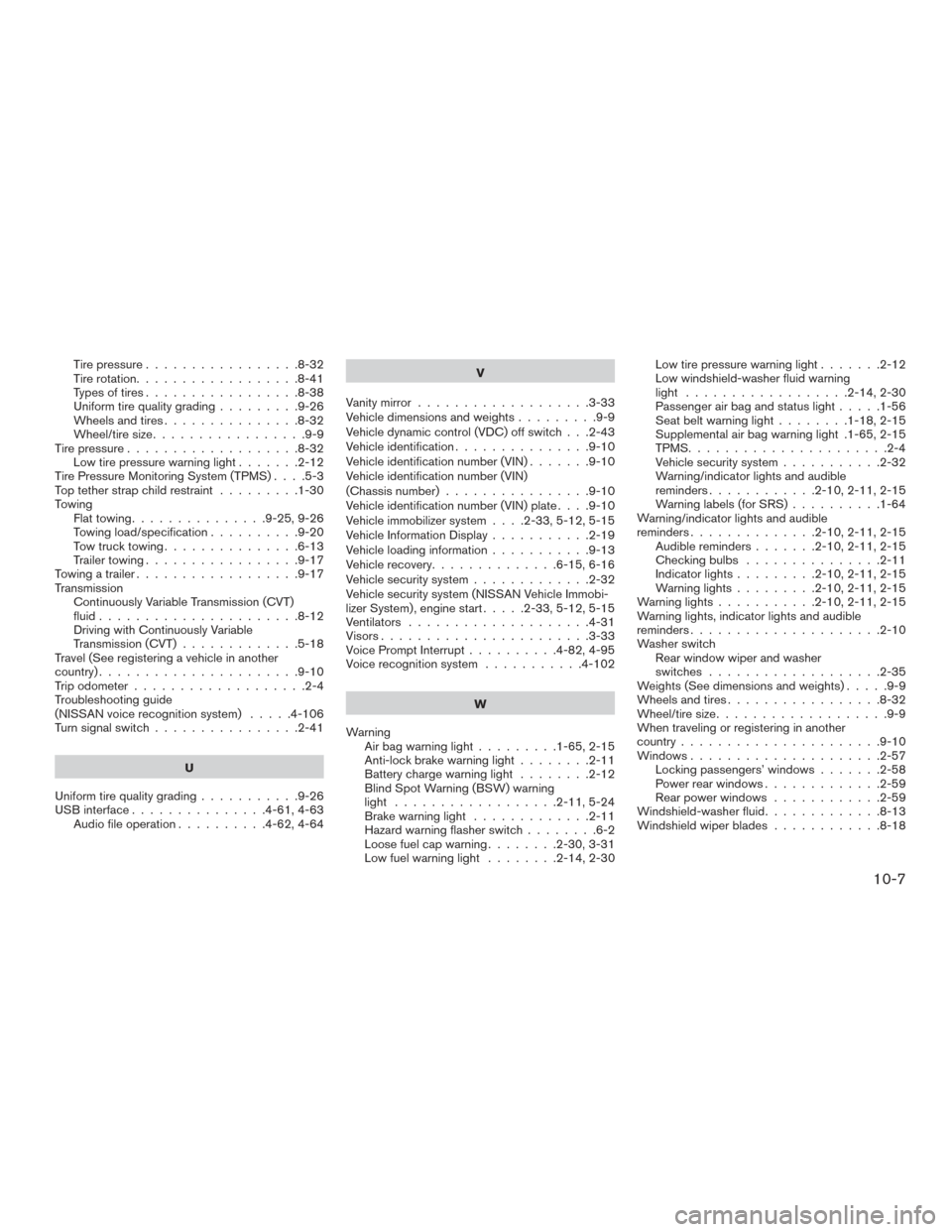
Tirepressure.................8-32
Tire rotation..................8-41
Types of tires.................8-38
Uniform tire quality grading .........9-26
Wheels and tires ...............8-32
Wheel/tire size .................9-9
Tirepressure...................8-32 Low tire pressure warning light .......2-12
Tire Pressure Monitoring System (TPMS) ....5-3
Top tether strap child restraint .........1-30
Towing Flattowing...............9-25,9-26
Towing load/specification ..........9-20
Towtrucktowing...............6-13
Trailer towing .................9-17
Towing a trailer ..................9-17
Transmission Continuously Variable Transmission (CVT)
fluid......................8-12
Driving with Continuously Variable
Transmission (CVT) .............5-18
Travel (See registering a vehicle in another
country) ......................9-10
Trip odometer ...................2-4
Troubleshooting guide
(NISSAN voice recognition system) .....4-106
Turn signal switch ................2-41
U
Uniform tire quality grading ...........9-26
USB interface ...............4-61,4-63
Audio file operation ..........4-62,4-64 V
Vanity mirror ...................3-33
Vehicle dimensions and weights .........9-9
Vehicle dynamic control (VDC) off switch . . .2-43
Vehicle identification ...............9-10
Vehicle identification number (VIN) .......9-10
Vehicle identification number (VIN)
(Chassis number) ................9-10
Vehicle identification number (VIN) plate ....9-10
Vehicle immobilizer system ....2-33,5-12,5-15
Vehicle Information Display ...........2-19
Vehicle loading information ...........9-13
Vehicle recovery ..............6-15,6-16
Vehicle security system .............2-32
Vehicle security system (NISSAN Vehicle Immobi-
lizer System) , engine start .....2-33,5-12,5-15
Ventilators ....................4-31
Visors.......................3-33
Voice Prompt Interrupt ..........4-82,4-95
Voice recognition system ...........4-102
W
Warning Airbagwarninglight.........1-65,2-15
Anti-lock brake warning light ........2-11
Battery charge warning light ........2-12
Blind Spot Warning (BSW) warning
light ..................2-11,5-24
Brake warning light .............2-11
Hazard warning flasher switch ........6-2
Loose fuel cap warning ........2-30,3-31
Lowfuelwarninglight ........2-14,2-30 Low tire pressure warning light
.......2-12
Low windshield-washer fluid warning
light ..................2-14,2-30
Passenger air bag and status light .....1-56
Seat belt warning light ........1-18,2-15
Supplemental air bag warning light .1-65, 2-15
TPMS ......................2-4
Vehicle security system ...........2-32
Warning/indicator lights and audible
reminders ............2-10,2-11,2-15
Warning labels (for SRS) ..........1-64
W
arning/indicator lights and audible
reminders..............2-10,2-11,2-15 Audiblereminders.......2-10,2-11,2-15
Checkingbulbs ...............2-11
Indicatorlights.........2-10,2-11,2-15
Warning lights .........2-10,2-11,2-15
Warning lights ...........2-10,2-11,2-15
Warning lights, indicator lights and audible
reminders.....................2-10
Washer switch Rear window wiper and washer
switches...................2-35
Weights (See dimensions and weights) .....9-9
Wheels and tires .................8-32
Wheel/tire size ...................9-9
When traveling or registering in another
country ......................9-10
Windows .....................2-57
Locking passengers’ windows .......2-58
Power rear windows .............2-59
Rear power windows ............2-59
Windshield-washerfluid.............8-13
Windshieldwiperblades............8-18
10-7
Page 462 of 478
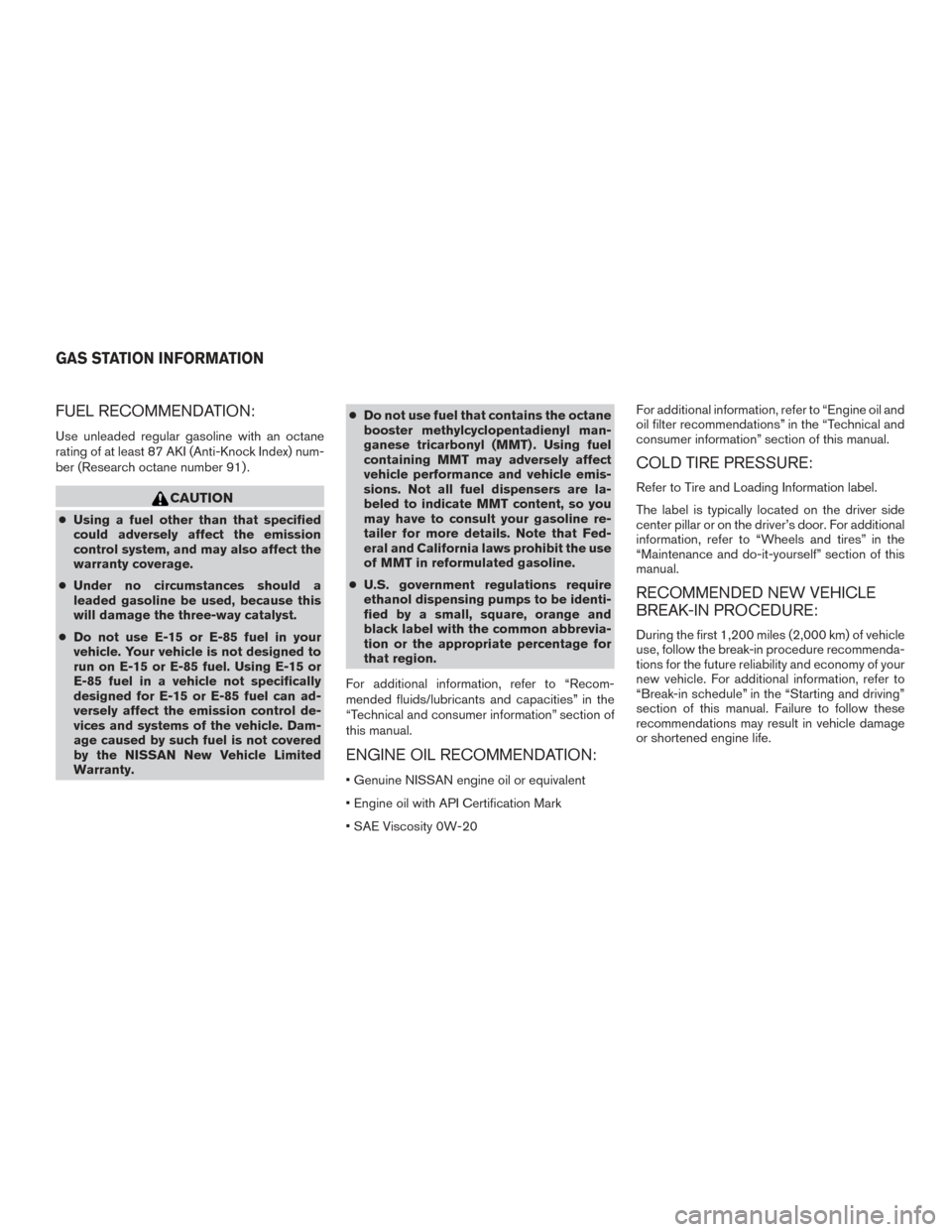
FUEL RECOMMENDATION:
Use unleaded regular gasoline with an octane
rating of at least 87 AKI (Anti-Knock Index) num-
ber (Research octane number 91) .
CAUTION
●Using a fuel other than that specified
could adversely affect the emission
control system, and may also affect the
warranty coverage.
● Under no circumstances should a
leaded gasoline be used, because this
will damage the three-way catalyst.
● Do not use E-15 or E-85 fuel in your
vehicle. Your vehicle is not designed to
run on E-15 or E-85 fuel. Using E-15 or
E-85 fuel in a vehicle not specifically
designed for E-15 or E-85 fuel can ad-
versely affect the emission control de-
vices and systems of the vehicle. Dam-
age caused by such fuel is not covered
by the NISSAN New Vehicle Limited
Warranty. ●
Do not use fuel that contains the octane
booster methylcyclopentadienyl man-
ganese tricarbonyl (MMT) . Using fuel
containing MMT may adversely affect
vehicle performance and vehicle emis-
sions. Not all fuel dispensers are la-
beled to indicate MMT content, so you
may have to consult your gasoline re-
tailer for more details. Note that Fed-
eral and California laws prohibit the use
of MMT in reformulated gasoline.
● U.S. government regulations require
ethanol dispensing pumps to be identi-
fied by a small, square, orange and
black label with the common abbrevia-
tion or the appropriate percentage for
that region.
For additional information, refer to “Recom-
mended fluids/lubricants and capacities” in the
“Technical and consumer information” section of
this manual.
ENGINE OIL RECOMMENDATION:
• Genuine NISSAN engine oil or equivalent
• Engine oil with API Certification Mark
• SAE Viscosity 0W-20 For additional information, refer to “Engine oil and
oil filter recommendations” in the “Technical and
consumer information” section of this manual.
COLD TIRE PRESSURE:
Refer to Tire and Loading Information label.
The label is typically located on the driver side
center pillar or on the driver’s door. For additional
information, refer to “Wheels and tires” in the
“Maintenance and do-it-yourself” section of this
manual.
RECOMMENDED NEW VEHICLE
BREAK-IN PROCEDURE:
During the first 1,200 miles (2,000 km) of vehicle
use, follow the break-in procedure recommenda-
tions for the future reliability and economy of your
new vehicle. For additional information, refer to
“Break-in schedule” in the “Starting and driving”
section of this manual. Failure to follow these
recommendations may result in vehicle damage
or shortened engine life.
GAS STATION INFORMATION